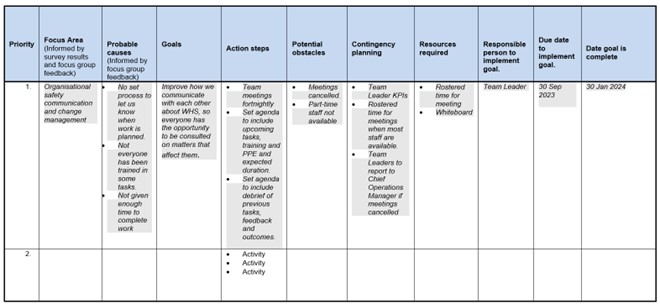Action plan guide
This guide provides tips and examples on how to develop an action plan.
Creating an action plan using your survey results and focus group discussions can help your business focus on key issues and agree on interventions, controls and resources needed to address these. Your action plan should:
- state goals in a clear succinct manner
- detail actions from start to finish
- identify resources needed
- nominate people responsible for each goal
- include a timeline to achieve each goal
- state monitoring activities to be undertaken.
Guidance materials to help you implement controls to improve your work health and safety (WHS), and recovery and return to work (RTW) are available at safety capability, leadership and culture. We recommend a good place to start and focus your efforts, is on the three lowest-scoring focus areas identified in your survey results.
Action plan steps
Follow these steps to guide you through the action plan process.
Step 1 - Prepare
Before developing your action plan, make sure you complete the following activities well in advance:
- your safety capability survey results have been distributed to and discussed with staff
- feedback from the follow-up focus group/s has been shared with staff
- your facilitator for the action planning session has been nominated
- potential participants in your action planning session have been identified, to ensure diversity in people, seniority and work areas
- invitations have been sent to participants outlining the purpose of the session
- logistics have been arranged (i.e. venue, name tags, writing materials and refreshments).
Your action plan team should be representative of the diversity of workers and levels of management to ensure it reflects their views and meets the needs of your workplace.
Step 2 – Set goals
Establish clear goals to help set your action plan up for success.
You can follow these steps to help guide your discussions:
- review the results from the safety capability survey and focus groups and focus on the lowest scoring areas.
- discuss and identify issues and write them on a display board—at this stage, do not discuss the appropriateness of the results or seek to eliminate conflicting issues
- ask participants to discuss the issues and prioritise these for action—if issues are complex or multi-faceted and may take longer to implement, you could start by prioritising shorter term issues that are easier to resolve (quick wins) to demonstrate your commitment to improving safety capability
- where there is conflict about how goals should be achieved, you may need to consider further discussions to work through and resolve points of difference
- when you identify an issue, develop a statement to clarify your goal—you can use the SMART criteria to help you do this.
Ensure goals are SMART goals:
Reference: Doran, G. T. (1981). There is a S.M.A.R.T. way to write management’s goals and objectives. Management Review, 70, 35-36
Step 3 – Develop your action plan
Your action plan should contain the steps and strategies required to implement your goals. As a group, develop a specific action or series of actions needed to achieve each goal. It is that simple. Then enter the details into the safety capability action plan template (DOCX, 0.79 MB) so it is clear what is required and who is responsible.
Ensure your action plan can deliver results, by keeping it realistic and practical.
Your plan should include:
- resources needed to implement the action or series of actions for each goal
- timeframes to achieve each goal
- who will be responsible for each goal and how it will be implemented?
- contingency planning for potential obstacles or problems that may occur
- agreement on review and feedback mechanisms to monitor if plans are working and are on schedule.
This example of the Action Plan template will help you get started.
safety capability action plan template (DOCX, 0.79 MB)
Step 4 – Monitor your action plan
We recommend you monitor and review the effectiveness of your action plan to ensure it is helping to achieve your goals. If you are not seeing positive results, you should consult with staff and revisit your action steps to see where improvements can be made.
Safety capability: Guide for reviewing and monitoring (DOCX, 0.79 MB) an action plan explains how to review the effectiveness and impact of your action plan.
By administering the Safety capability survey periodically at your workplace and monitoring the findings and agreed actions, it will help you measure how capable and prepared your business is to manage any WHS and recovery and RTW challenges that lie ahead.

